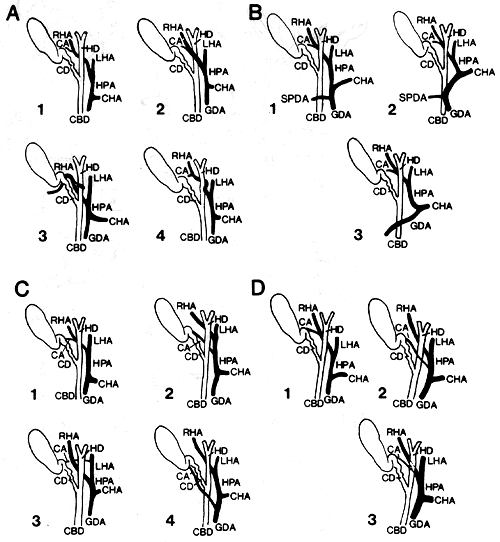

Illustrated Encyclopedia of Human Anatomic Variation: Opus II: Cardiovascular System
Ronald A. Bergman, PhD
Adel K. Afifi, MD, MS
Ryosuke Miyauchi, MD
Peer Review Status: Internally Peer Reviewed

RHA, Right hepatic artery; LHA, left hepatic artery; HPA, main hepatic artery; CHA, common hepatic trunk; GDA, gastroduodenal artery; CA, cystic artery; HD, main hepatic duct; CD, cystic duct; CBD, common bile duct; SPDA; superior pancreatoduodenal artery.
A: Relations of the right hepatic artery to the main hepatic duct. 1: In 70% the right hepatic artery runs behind the main hepatic duct and the cystic artery arises just beyond right edge of duct.
2: In 12% the right hepatic artery passes in front of the main hepatic duct before entering right lobe of the liver.
3: In 10% the right hepatic artery runs parallel to the cystic duct throughout its course and lies in close proximity to the neck of the gallbladder before entering right lobe of the liver. Artery could be easily injured during cholecystectomy.
4: In 8% the right hepatic artery passes across right edge of the main hepatic duct and then enters liver or forms a ring around the hepatic duct.
B: Variations of the gastroduodenal artery in relation to the common duct. 1: In 42% a branch of the gastroduodenal artery crosses the common duct.
2: In 38% the gastroduodenal artery arches across the left border of the common duct.
3: In 20% the gastroduodenal artery itself crosses in front of the common duct.
C: Abnormalities in the origin of the single cystic artery. 1: There is only one cystic artery in 88% of individuals. In 82% of these it arises from the right hepatic artery.
2: In 3% of the 88% the cystic artery arises from the main hepatic.
3: In 2% of the 88% the cystic artery arises from the left hepatic.
4: In 1% of the 88% the cystic artery arises from the gastroduodenal artery. This is a very important anomaly if the cystic artery is only looked for in its usual place, i.e., arising from the right hepatic.D: Relation of the single cystic artery to the main hepatic duct. 1: In 71% the cystic artery arises to the right of the main hepatic duct.
2: In 27% the cystic artery arises on the left side of the hepatic duct or common duct and must cross one of these to reach neck of gallbladder.
3: In 2% the cystic artery arises behind the main hepatic duct, and if it should be retracted, it is easy to include duct in grasp of forceps.
Redrawn from Eisendrath, D.N. The clinical importance of anatomical anomalies in biliary surgery. Boston Med. Surg. 182:573-578, 1920.
Section Top | Title Page
Please send us comments by filling out our Comment Form.
All contents copyright © 1995-2025 the Author(s) and Michael P. D'Alessandro, M.D. All rights reserved.
"Anatomy Atlases", the Anatomy Atlases logo, and "A digital library of anatomy information" are all Trademarks of Michael P. D'Alessandro, M.D.
Anatomy Atlases is funded in whole by Michael P. D'Alessandro, M.D. Advertising is not accepted.
Your personal information remains confidential and is not sold, leased, or given to any third party be they reliable or not.
The information contained in Anatomy Atlases is not a substitute for the medical care and advice of your physician. There may be variations in treatment that your physician may recommend based on individual facts and circumstances.
URL: http://www.anatomyatlases.org/